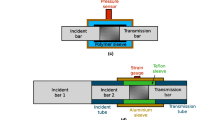Abstract
A parallel-plate rheomete was constructed and used to study the development of dynamic shear modulus and cell opening under forced adiabatic conditions for a series of flexible slabstock polyurethane foams. Typical industrial formulations were used. The plates were heated to follow the adiabatic temperature profile of a real foam bun during foaming. The rheometer overcomes difficulties encountered in other methods such as heat loss and bubble damage caused by the probe.
A four-stage modulus development profile was observed: initial bubble growth, bubble network, polymer stiffening and final curing. Chemical structure development was also studied under forced adiabatic conditions, using Fourier transform infrared spectroscopy. Polymer stiffening coincided with bidentate (hydrogen-bonded) urea formation.
The normal force exerted by the expanding foam on the plates was found to be a function of the rate of foam expansion and the foam modulus. A sudden drop in the normal force typically coincides with the visually observed blow-off in the reacting foam bun, thus the normal force profile is a new and accurate indicator of cell opening. The normal force profile clearly shows that cell opening occurs just after the onset of polymer stiffening, thus illustrating the role of polymer rheology in the cell opening mechanism.
Similar content being viewed by others
References
Armistead JP, Wilkes GL, Turner RB (1988) Morphology of water-blown flexible polyurethane foams. J Appl Polym Sci 35:601
Artavia LD (1991) A model for low density foams. PhD thesis, University of Minnesota, Minneapolis, MN
Artavia LD, Macosko CW (1989) Dynamic mechanical spectroscopy testing of foams. Proceedings of the 18th Annual NATAS, San Diego, CA, pp 271–282
Artavia LD, Macosko CW (1990) Foam kinetics. J Cell Plast 26:490
Artavia LD, Macosko CW, Priester RD, Schrock AK, Turner RB (1992) Volume rise during flexible urethane foaming. Polym Reaction Eng 1:203
Artavia LD, Macosko CW (1994) In: Hilyard NC, Cunningham A (eds) Low density cellular plastics. Chapman and Hall, London, pp 22–56
Bailey FEJ (1991) Flexible polyurethane foam. In: Klempner D, Frisch KC (eds) Polymeric foams. Hanser, New York, pp 47–72
Bailey FEJ, Critchfield FE (1981) Chemical reaction sequence in the formation of water-blown, urethane foam. J Cell Plast 17:333
Bird RB, Armstrong RC, Hassager O (1987) Dynamics of polymeric liquids. Wiley, New York, pp 52–53
Carriere CJ, Bank DH, Christenson CP (1992) A pulse rheometer for reacting foams. Polym Eng Sci 32:426
Gibson LJ, Ashby MF (1982) The mechanics of three-dimensional cellular materials. Proc R Soc Lond A 382:43–59
Kanner B, Decker TG (1969) Urethane foam formation — role of the silicone surfactant. J Cell Plast 5:32
Koztrzewski W, Lindt JT (1985) Foam rheometer: its principle and applications. J Cell Plast 21:424
Koztrzewski W, Lindt JT (1986) Flow characterization of a chemically-blown polymeric foam III. J Polym Eng 6:187
Kraynik AM (1988) Foam flows. Ann Rev Fluid Mech 20:325–357
Kraynik AM, Hansen MG (1986) Foam and emulsion theology: a quasistatic model for large deformations of spatiallyperiodic cells. J Rheol 30:409–439
Macosko CW (1989) RIM: Fundamental of reaction injection molding. Hanser, Munich
Macosko CW (1994) Rheology: principles, measurements and applications. VCH Publishers, New York, pp 3 ff
McClusky JV, O'Neill RE, Priester RD Jr, Ramsey WA (1994a) Vibrating rod viscometer: a valuable probe into polyurethane chemistry. J Cell Plast 30:44
McClusky JV, Prieser RD Jr, O'Neill RE, Willkomm WR, Heaney MD, Chapel MA (1994b) The use of FTIR and dynamic SAXS to provide an improved understanding of the matrix formation and viscosity build of flexible polyurethane foams. J Cell Plast 30:338
Miller TE, Schmidt DL (1983) Methods for detecting cell opening and rate-of-rise in flexible foams. J Cell Plast 19:326
Mora E, Artavia LD, Macosko CW (1991) Modulus development during flexible urethane foaming. J Rheol 35:921
Neff R, Adedeji A, Macosko CW (1996) Urea hard segment morphology in flexible polyurethane slabstock foam. In preparation
Neff R, Macosko CW (1996) A model for modulus build in flexible polyurethane foam. J Polym Sci Phys, submitted
Priester RD, McClusky JV, O'Neill RE, Turner RB, Harthcock MA, Davis BL (1990) FTIR — a probe into the reaction kinetics and morphology development of urethane foams. J Cell Plast 26:346
Princen HM, Kiss AD (1986) Rheology of foams and highly concentrated emulsions: III. Static shear modulus. J Coll Int Sci 112:427
Reinelt DA (1993) Simple shearing flow of three-dimensional foams and highlyconcentrated emulsions with planar films. J Rheol 37:1117–1139
Reinelt DA, Kraynik AM (1990) On the shearing flow of foams and concentrated emulsions. J Fluid Mech 215:431–455
Reinelt DA, Kraynik AM (1993) Large elastic deformations of three-dimensional foams and highly-concentrated emulsions. J Coll Int Sci 159:460–470
Rossmy G, Kollmeier HH, Lidy W, Schator H, Wiemann M (1977) Cell opening in one-shot flexible polyether based polyurethane foams. The silicone surfactant and its foundation in the chemistry of foam formation. J Cell Plast 13:26
Rossmy G, Kollmeir HH, Lidy W, Schator H, Wiemann M (1981) Mechanism of the stabilization of flexible polyether polyurethane foams by silicone-based surfactants. J Cell Plast 17:319
Rossmy G, Lidy W, Schator H, Wiemann M, Kollmeier HH (1979) New aspects to the problem of temperature measurements in rising flexible polyether-polyurethane foams. J Cell Plast 15:276
Saunders JH (1960) The formation of urethane foams. Rubber Chem and Tech 33:1293
Saunders JH, Frisch KC (1962) Polyurethanes: chemistry and technology, vols I and II. Wiley, New York
Webb DD (1984) Urethane systems reactivity measurement. Proceedings of the SPI 28th Annual Technical/Marketing Conference, San Antonio, TX, pp 2–5
Yasunaga K, Neff RA, Zhang XD, Macosko CW (1996) Study of cell opening in flexible polyurethane foam. J Cell Plast 32:427
Yasunaga K, Zhang X, Macosko CW (1996b) Top skin formation in flexible polyurethane foam. Submitted to J Cell Plast in press
Author information
Authors and Affiliations
Additional information
Dedicated to the memory of Professor Tasos C. Papanastasiou
Rights and permissions
About this article
Cite this article
Neff, R.A., Macosko, C.W. Simultaneous measurement of viscoelastic changes and cell opening during processing of flexible polyurethane foam. Rheola Acta 35, 656–666 (1996). https://doi.org/10.1007/BF00396514
Received:
Accepted:
Issue Date:
DOI: https://doi.org/10.1007/BF00396514




